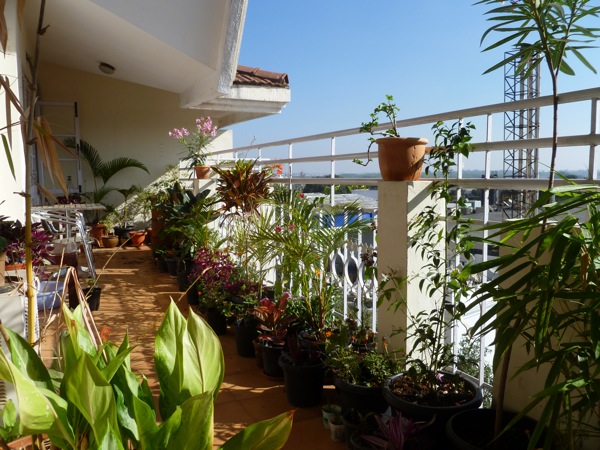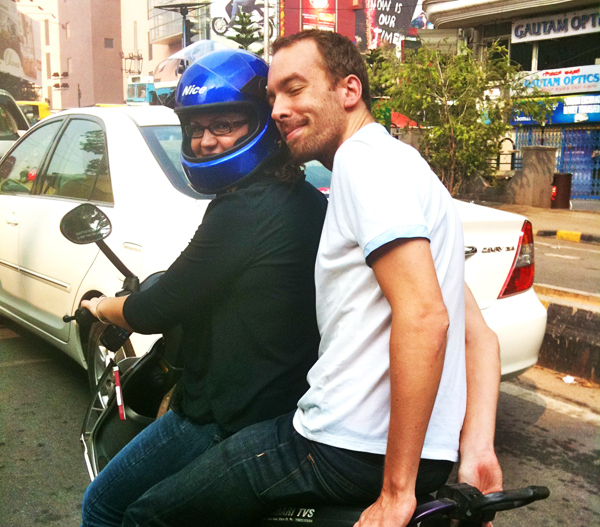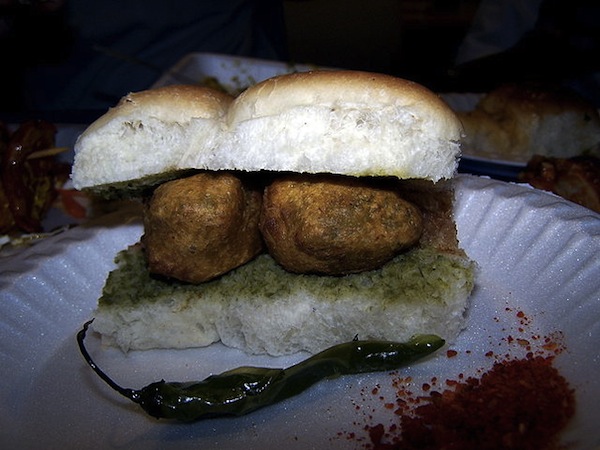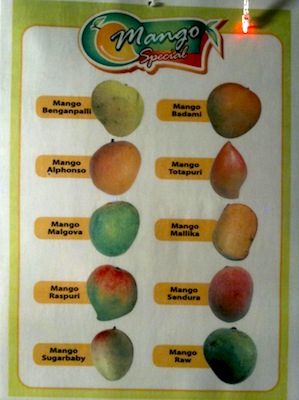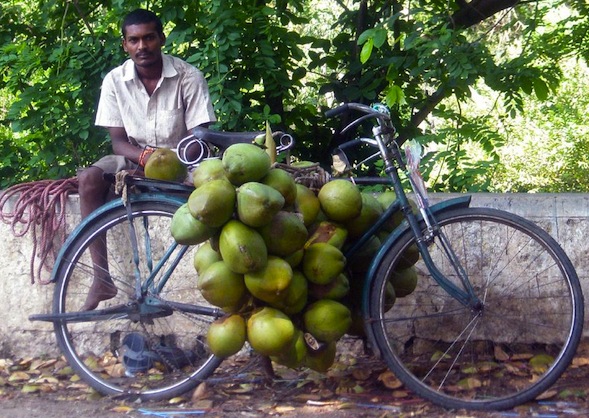So I started a “Festive 50″countdown just before Christmas, but didn’t get to the end of it yet… mainly because I’ve been working absolutely flat-out at college since the start of January, and I’ve just been utterly exhausted. Plus I couldn’t decide on the categories for the last 20… :P
Anyway, after Birds, Words and Food, here comes Part 4… LIFE. Here are 10 of the most notable ways in which life has changed since moving to India.
#20: Weather
 A pretty obvious one to begin with — the weather here is really different from back in the UK, and particularly from Edinburgh. I’m told that summer “officially” starts here tomorrow with the Maha Shivaratri festival… not sure about that, but it’s certainly warm and sunny now, and in fact it’s been around 30-32°C for 2 or 3 weeks already, and it hasn’t rained in over a month. I’m generally used to the heat now — back home I used to prefer walking around most of the time, but I’ve learned not to do that here when it’s hot, because you quickly get sweaty and exhausted.
A pretty obvious one to begin with — the weather here is really different from back in the UK, and particularly from Edinburgh. I’m told that summer “officially” starts here tomorrow with the Maha Shivaratri festival… not sure about that, but it’s certainly warm and sunny now, and in fact it’s been around 30-32°C for 2 or 3 weeks already, and it hasn’t rained in over a month. I’m generally used to the heat now — back home I used to prefer walking around most of the time, but I’ve learned not to do that here when it’s hot, because you quickly get sweaty and exhausted.
Night-time was harder to get used to though, in terms of discovering what bedding is appropriate for very warm nights, making sure there’s some kind of through-draught, deciding whether to use the air conditioning or not, and leaving the ceiling fan on all night.
But the main thing that makes a difference to the quality of life here is sunshine. There’s lots of it, and it’s reliable. I’d never been that great at getting up in the morning before now, but sometimes here I literally jump out of bed, energised by the sun streaming in the bedroom window. Definitely thumbs-up for Bangalore weather.
#19: Health
On the other hand, thumbs-down generally for Bangalore in the health department. I never used to get sick much back home, maybe flu once a year and the occasional head-cold. But here I regularly get colds, a sore throat, and in particular bad sinuses and headaches to go with them. I guess this is down to the notorious air pollution here, and especially the dust. One of the downsides of regular sunshine and little or no rain is that the streets get really dusty, and the traffic whips this up into the air. Sometimes when you walk home in the dark you can see it in the air, lit up by the beams of car headlights like when you shine a torch through smoke.
It’s very common to see people walking down the street with a hanky over their nose and mouth (I do this myself when it’s really bad), and women quite often wrap a scarf right around their head several times to protect their face and hair from the dust. On the plus side though, the arthritis that I was starting to get in my hand back home has pretty much vanished — presumably due to the warmer weather.
#18: Traffic and Travel
(This will be a long one, because I’ve been meaning to write about this for ages but didn’t get around to it.)
As I’ve mentioned a few times before, the traffic in Bangalore is very bad, and downright terrifying at times for a (foreign) pedestrian. Drivers show scant regard for the rules of the road, and although everyone notionally drives on the left, it seems to be generally accepted that you can travel on whichever side of the road you like, if it seems appropriate or opportune to do so for over-taking or for sneaking up to the front of a queue of traffic waiting at a red light. Cycles and “2-wheelers” in particular will quite happily ride completely the wrong way up a 1-way street, or even on a dual carriageway.
There also seems to be no concept of “giving way”. Quite the opposite in fact: the rule seems to be “if you see a gap, get into it”. At cross-roads with no signals and where people are turning right this can cause havoc, and one of the junctions near me regularly gets completely jammed up and comes to a standstill because nobody lets anyone by.
And of course there’s the legendary Indian use of the horn, which makes the traffic really noisy, and the larger the vehicle the louder the horn. Some of the buses leave your ears ringing when they use their horn nearby.
The traffic is very mixed here, forming a kind of eco-system. At the top end of the chain, and not to be argued with, are the huge coaches and buses. Brightly-painted with a mixture of logos, company names, and usually Hindu deities, they speed along, presumably travelling long distances. And the Indian trucks are amazing — again brightly coloured but also with extra hand-painted features including eyes on the front, various other mystical symbols, and the famous “Horn OK Please”, “Sound Please Horn” or some variant on the back. 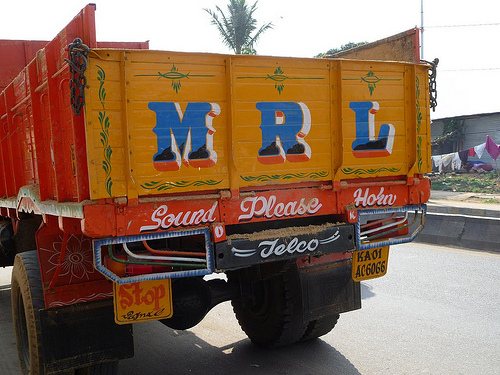 Then there are private cars: from the conspicuous wealth in the form of huge 4×4’s, down to the really cool old classic Indian cars: particularly the Hindustan Ambassador, based on the Morris Oxford Series III from the 1950’s and usually either a police car or a taxi, and the Premiere Padmini which looks like a 1960’s Fiat of some kind. There are also some very small cars, like the Tata Nano which was the cheapest car in the world when it was launched, and the even smaller Mahindra Reva, a 2-seater electric car that’s actually made in Bangalore, and which I recognised from London, since it’s sold in the UK as the G-Wiz.
Then there are private cars: from the conspicuous wealth in the form of huge 4×4’s, down to the really cool old classic Indian cars: particularly the Hindustan Ambassador, based on the Morris Oxford Series III from the 1950’s and usually either a police car or a taxi, and the Premiere Padmini which looks like a 1960’s Fiat of some kind. There are also some very small cars, like the Tata Nano which was the cheapest car in the world when it was launched, and the even smaller Mahindra Reva, a 2-seater electric car that’s actually made in Bangalore, and which I recognised from London, since it’s sold in the UK as the G-Wiz. 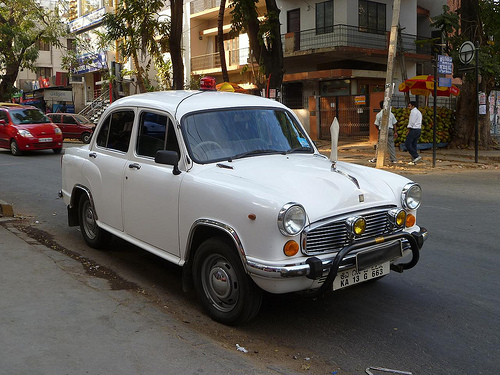
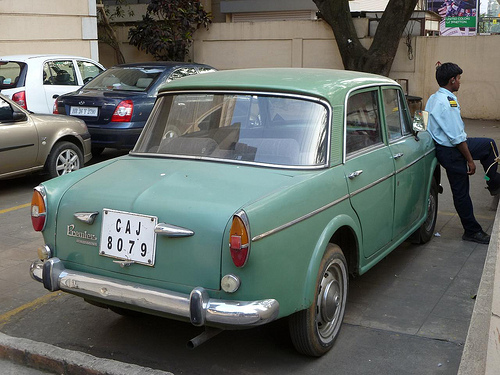 Next down the list: Tractors! Whether the local Mahindra type, or the familiar Massey Ferguson, tractors are the industrial small vehicle of choice for pretty much everything here. Usually pulling a flat-bed truck, which itself usually has a bunch of daily-waged construction workers — both male and female — sitting in it. The tractors here look pretty much like you’d see on any farm back home, except they have Indian trimmings: eyes painted on, mystic symbols, evidence of puja (chillis/limes on a string), tinsel or flower garlands hanging off the front, etc. They’re usually belching out some pretty dirty fumes.
Next down the list: Tractors! Whether the local Mahindra type, or the familiar Massey Ferguson, tractors are the industrial small vehicle of choice for pretty much everything here. Usually pulling a flat-bed truck, which itself usually has a bunch of daily-waged construction workers — both male and female — sitting in it. The tractors here look pretty much like you’d see on any farm back home, except they have Indian trimmings: eyes painted on, mystic symbols, evidence of puja (chillis/limes on a string), tinsel or flower garlands hanging off the front, etc. They’re usually belching out some pretty dirty fumes.

Then below that in the pecking order you get 3-wheelers: the ubiquitous auto-rickshaws, and lots of related sub-species that have been converted into delivery vans, garbage trucks etc. I’ve read that there are around 75,000 auto-rickshaws on the streets of Bangalore. (There is so much I could write about the rickshaws… I think I’ll save some of it for another post.) 
 And then the “2-wheelers”, as they’re known. By far the most common vehicle, the streets here are absolutely packed with scooters and motorbikes. Again, ranging from the lowliest, decrepit old Bajaj scooter looking like an old Vespa, through lots of more modern scooters and smaller bikes up to the classic, noisy and extremely cool-looking Royal Enfield motorbikes like the Bullet.
And then the “2-wheelers”, as they’re known. By far the most common vehicle, the streets here are absolutely packed with scooters and motorbikes. Again, ranging from the lowliest, decrepit old Bajaj scooter looking like an old Vespa, through lots of more modern scooters and smaller bikes up to the classic, noisy and extremely cool-looking Royal Enfield motorbikes like the Bullet.
It’s very common to see electric scooter for adults and motorbikes carrying 3 smallish adults (South Indian people aren’t big), or 2 adults and 2 kids. Mum is always sitting on the back, more often than not side-saddle in her saree, and will sometimes be holding a small baby in her arms. This still scares the hell out of me when I see it…  And further down we go… in the Bangalore traffic eco-system there are quite a few species towards the bottom of the food chain. In order of size and possible priority, you will see Bullock Carts (often carrying pretty heavy loads, like steel girders going to a construction site) and Tangas with their two huge cart-wheels being pulled by a pony.
And further down we go… in the Bangalore traffic eco-system there are quite a few species towards the bottom of the food chain. In order of size and possible priority, you will see Bullock Carts (often carrying pretty heavy loads, like steel girders going to a construction site) and Tangas with their two huge cart-wheels being pulled by a pony.
Much more common are hand-carts, which are pushed down the road, often through very busy traffic, and which are loaded up with fresh fruit and vegetables, sometimes plants and flowers, or rugs. There are lots of sellers of Guavas and Musambi (Sweet Lime) juice here too. Dhobi-wallahs here park up their hand-cart in a regular spot so they can do their ironing somewhere in the shade, using a Victorian-looking iron that they load up with hot charcoals. 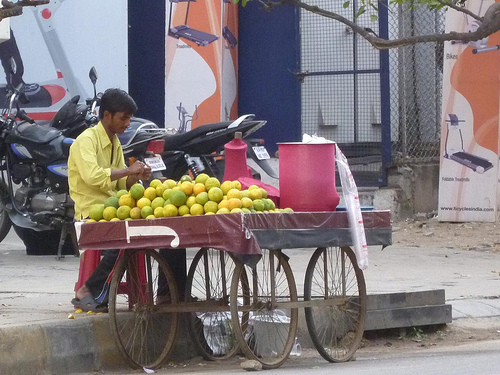 So I guess next lowest in the hierarchy would be tricycles. Most of them here seem to be used by rag-pickers to transport the recyclable garbage they’ve been collecting. (Although I’ve seen one in Jaipur with a 3-piece suite strapped onto the back! Really!) Occasionally you see a tricycle rickshaw here, although they’re not very common. Which is a shame because they’re often beautiful old things, even if they are falling apart.
So I guess next lowest in the hierarchy would be tricycles. Most of them here seem to be used by rag-pickers to transport the recyclable garbage they’ve been collecting. (Although I’ve seen one in Jaipur with a 3-piece suite strapped onto the back! Really!) Occasionally you see a tricycle rickshaw here, although they’re not very common. Which is a shame because they’re often beautiful old things, even if they are falling apart.

And then, a very small notch above pedestrians are the bicycles. I’ve seen a few mountain bikes (most of which look like some kind of toy-shop idea of what a decent bike should be), but by far the most common are the ancient-looking BSA Hercules type. As with the motorised 2-wheelers, it’s not uncommon to see more than one person on a bicycle… I often see 2 on a bike, with the passenger sitting on the super-heavy-duty carrier on the back. I also sometimes see dads taking 2 kids to school on a bicycle too: one on the carrier and the other sitting on the frame at the front.
Occupying a hypothetical slot at this point would also be hand-pulled rickshaws, but I’ve never seen one in Bangalore. I was in Calcutta briefly last year and saw lots of them there… looking just like something out of a movie about 1920’s Shanghai: two long poles that the rickshaw-wallah holds, as he runs along the road — usually barefoot — pulling 1 or 2 passengers behind him, through the traffic and the pollution. Those guys really earn their money!
#17: Eating and Drinking
OK, so I already wrote quite a bit about food in part 3 of this series, but eating itself is also different here. Generally here, you eat with your fingers. I was surprised how quickly this became second-nature… to the extent that I have been almost at the end of a meal and only then realised that nobody brought me any cutlery. I’ve learnt some new techniques too — eating with your fingers, you hold your wrist away from your mouth and point all your fingers towards it; and in fact this gesture is used to refer to eating, notably by people begging for money for food.
Eating rice with the fingers needs a bit of practice, but I think I’ve got that down as well. Not that I do it very often, but if you go for a traditional South Indian meal that’s served on a banana leaf, you eat absolutely everything with your fingers, and rice is definitely the trickiest! The secret — or at least what works for me — as taught by my former colleague Sonia, is to hold your palm upwards, and use your thumb to slide the rice into your mouth.
Another question concerns which hands to use. Guidebooks for holiday-makers visiting India will warn you that you absolutely must eat only with your right hand, because the left hand is used for cleaning and, erm, toilet duties. In practice, in Bangalore at least, you see plenty of people using their left hand from time to time (just as you see women wearing clothes that expose bare shoulders, and all these other things that are supposed to go against tradition). My usual strategy is to observe how people around me are behaving — if I’m in a small, traditional place then I’ll use my right hand only, which can be tricky when you’re tearing a piece off a naan or a roti, but I can generally manage. But in the larger and more modern places, or where they’re serving Western food, nobody seems to care really.
And finally, drinking…. I really can’t do this the local way. If you watch an Indian person drinking from a water bottle — or at a roadside Chaat stall, often from a communal metal cup, or a jug — then they will do it by pouring the water into their mouth without touching it. I’ve given up even trying to do this in public, because I always end up soaking myself!
#16: Energy
Again, I’ve mentioned this on the blog several times already, but your attitude to energy really has to change when you come to India. Electricity is badly-behaved (big voltage fluctuations) and power-cuts are frequent, even in a supposedly hi-tech city like Bangalore.
Most commercial premises have their own generators to cover such eventualities, ranging from tiny diesel generators like you might see on a campsite in Europe, which are usually sitting outside the smaller shops, up to huge and supposedly super-silent gen-sets the size of a lorry sitting outside large office buildings, and with huge chimneys rising 100m+ into the air. There’s also no mains gas, so anyone who wants to cook with gas has a hob that’s plumbed into a bottle of LPG. Whenever I cook, the fumes I can smell remind me of going camping.
There’s also a huge beaurocratic problem around getting hold of gas bottles — presumably because the government thinks they could be used for terrorism. Fortunately I’ve not run into it yet, because other people have always arranged to get the gas for me, but as far as I can tell loads of paperwork and documentation are required to register for gas ownership and delivery. I’m also told that there’s a black market supply which avoids all of this.
#15: Water
Similarly — water. Mains water supplies are not universal here. Many people have a private bore-well on their property, while others have access to a mains supply that gets pumped round, but only at certain times of the day. Pretty much every building has a black plastic water-tank sitting on the roof, ready to receive this. But the main issue is that most water isn’t safe to drink. And in some places, it’s badly contaminated. So there’s a whole industry based around water filtration, ozone/UV treatment, and of course buying and delivering packaged, drinkable water. Many places have their water delivered by a big tanker. In the first flat I lived in, I used an electric water purifier, which was connected to a private source of “sweet” water, but still tasted pretty awful on its own.
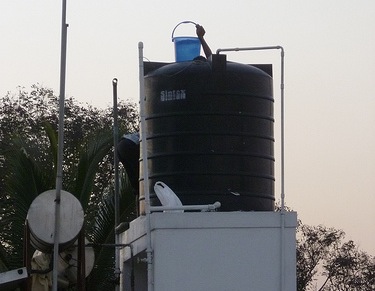
In the new flat I moved into in January, there’s a purifier but I’ve not used it (the maid tried it, but gave up). So instead I get water delivered from a local shop in 20 Litre containers, the same as those used in commercial water-coolers. These last 2-3 weeks, since I’m out at work most of the time, and I pay Rs 70 (about 90p) which is a bit of a rip-off, since the MRP is only Rs 35, but then again some guy has to cycle round with this 20kg weight and put it onto the tank thing in my kitchen.
But the general difference is that you can’t take anything for granted. Back home gas, water and electricity are there 24/7 and you hardly even think about them. Here, there’s nearly always some interruption which reminds you how much you rely on them. Over the past year we’ve had several days in college when we had to give up trying to teach classes because we had no power.
#14: Norms
A much more subtle difference perhaps, but the local social norms are something that affect you every day, whether you consciously notice them or not. Some things are just noticeably different. The thing that hit me strongest when I first arrived is that there are just so many people here — streets are always busy and crowded, and generally you don’t expect to have any privacy. Bangalore is noisy, the traffic is just crazy (see above), and everywhere is busy. One thing I really miss here is solitude and tranquility.
Public displays of affection (“PDA’s”) between couples are frowned upon to a greater or lesser extent depending on which part of India you’re in, and yet you regularly see friends, usually male, walking down the street holding hands, or with their arms around each other’s shoulders. In the case of young men they can be in pretty large groups, all holding onto each other. I’m used to seeing this now, and find it quite charming… but it’s also odd in that where I grew up, you might have done this up to the age of 9 or 10, but no later. I’ve become used to doing many things since arriving here, but I wouldn’t be able to comfortably do this myself.
Dress here is also very different of course. Although Bangalore is pretty cosmopolitan and most of our students will turn up at college in something like jeans and T-shirts (except the fashion students), the majority of the local people, and especially women, wear traditional dress.
In the case of women this usually means Salwar Kameez (trousers, long-sleeved top and a ‘dupatta’ scarf), or a Saree with a fitted short-sleeved blouse (choli) underneath. A Saree can range from something that — frankly — looks like it could have been a curtain in the 1970’s, to some really exquisite piece of silk craftsmanship with stunning colours and often bits of gold woven into it. The colours can be really amazing, especially when they catch the bright sunlight. There’s an obvious connection here between the status of the wearer and what she’s wearing. I regularly see women looking really stunning in a beautiful saree… and as mentioned above, sometimes they’re sitting side-saddle on the back of a motorbike (with no helmet). A quintessentially Indian image as far as I’m concerned!
In Bangalore there’s also a bit of mixing of traditional and modern/western… younger people will often be seen wearing a kurta or kurti — a long or sometimes shorter traditional shirt — over their jeans. Sometimes women wear a sleeveless one, exposing their arms. Exposing bare skin in generally frowned upon in traditional elements of society here, and I’ve become so used to this that when I see foreigners walking around with arms and legs on display, I feel as surprised as the locals. I once went into the shopping mall next to work, where I go for my lunch most days, and there was a group of foreign blonde girls sitting in one of the coffee shops, wearing strappy tops and shorts or skirts. (Since everyone here has black hair, blondes get a lot of attention.) I was almost as gob-smacked as the local people who were all staring. It’s funny how quickly you can assimilate the local norms.
#13: Work
I’ve deliberately avoided writing about work on the blog, but suffice to say that it’s very different to the same job I was doing back home. The college where I teach design is part of a large multinational that operates across Asia, but is based in Singapore, and the Singapore work ethic is pretty pervasive. Having to be in college from 9am to 6pm every day, regardless of teaching duties, and scanning in and out with a fingerprint reader, feels pretty alien compared to the relaxed attitude of UK academia that I was used to for the last 20 years.
We have a huge amount of teaching to do as well compared to back home: in the contract it says up to 30 hours a week. Compare this to 18hrs which used to be the maximum in the UK allowed by teaching unions. On the other hand, I don’t do any work outside office hours, on principle — full stop. Which is quite liberating.
Something else which is really different in the Indian workplace is that there’s a noticeably strong sense of hierarchy among all the staff. Everyone “knows their place”, and if you don’t recognise and respect that then it makes people feel very uncomfortable. Having also worked in Malaysia, I’m pretty certain this is an Indian — rather than Asian — thing. It can make it difficult to get things done sometimes, because you need to negotiate the various power structures.
There are also other aspects of the Indian psyche that can be frustrating in the work environment, especially the tendency to avoid giving anyone “bad news”. This seems to mean that people will tell you what they think you want to hear, rather than the truth. When you’re trying to chase up an order for equipment, or find out where something has gone wrong, this can be infuriating.
#12: Language
I’ve written quite a bit about language here already. I guess that one unusual thing about India is how ubiquitous English is, at least in the large cities. But having said that, you’re always using a restricted, limited, international version of English which is sometimes verging on a pidgin.
Indian pronunciation and intonation has its own variations too… The first time I unintentionally pronounced “Where” with a ‘V’ at the start was quite a shock! But it’s normal pronunciation for local people, and you end up adopting the norms of everyone else after a while so that you can be understood better.
Add to that the international nature of the college where I work — and where I’m now the only native speaker of British English — and the result is that I often feel like my ability to speak my own language is being eroded, which is a really strange feeling. Plus your own language isn’t just about being able to speak correctly, it’s also one of the ways you express your personality, and especially your sense of humour. Working in an international environment, with people from different cultures and backgrounds, it’s interesting to see how a consensual sense of humour emerges. (Usually not very sophisticated, obviously.)
Apart from Hindi, Kannada and English, I regularly hear Spanish, Portuguese, Russian, French and Latvian being spoken at work, whether it’s between staff or when they skype with family back home.
As for the other languages, India has thousands of them, but I’ve been studying Hindi via skype lessons since last May, and I’ve also picked up a handful of words in Kannada, the local language of Karnataka. Hindi isn’t spoken much down here (more in the North), but some of the staff at college speak it, and it’s fun to try to chat with them in Hindi. Plus occasionally I’ll end up trying to explain something to a local person who doesn’t speak English — typically a driver or someone who hasn’t had the opportunities of education — and Hindi comes in pretty useful then.
#11: Patience
Having done quite a bit of research before I came out to India, I promised myself that I would try to be patient here and not to let things wind me up. I sometimes forget, but I think it’s probably the single best tactic for a Westerner trying to survive in India.
Bureaucracy here is unbelievable, and legendary. The amount of paperwork you need to be able to do almost anything official is stunning. When I had to renew my residency permit in December, after being here for a year, it took 3 days of travelling back and forth to the Foreigner’s Registration Office, with a stack of papers an inch thick. Apart from going to the FRO, I had to go to the police station to get a report, then to my flat to wait for the police to come round and check I actually lived there, then back to the FRO, and so on. And several times I was sent away because my paperwork wasn’t formatted “properly” — actually really trivial quibbles, but you can’t argue or reason with the people behind the counter, so you just have to do what they ask, no matter how silly it seems.
Most streets here have numerous shops offering XEROX services (photocopying), and there are lots of places offering passport photos while you wait. The reason for these small industries is clear to anyone who’s ever tried to apply for anything official. You always need passport photos to apply for anything, and usually a xerox of some official documents. And you really wouldn’t believe what you have to do just to get a SIM card for your phone here.
Once a month, I have to wire money back to the UK to pay for various bills. I usually do this on the first Saturday of the month, which means I have to work that morning. So I catch an auto from college to the city centre, where my bank is (30 mins). It’s packed, so I queue up for 30 mins just to get the forms I need to fill in. Then I fill those in and wait usually between an hour and an hour-and-a-half to see someone at the desk, who invariably tells me something different every time about why something I’ve filled in is wrong, and so we then sort that out. When it’s all done, I catch another rickshaw home — another 30 mins. So in total this takes around 3 hours, once a month, just to transfer money back to the UK, and it takes 2-3 days to arrive in my UK account. If I want to do a transfer in the opposite direction (rare) then I can do it online in less than 5 minutes and the money arrives in around 10 minutes.
But Indian bureaucracy is an immovable object, and there’s no point in trying to argue against it. You have to learn to be patient, and not to expect that anything will work out as you planned. You have to learn to worry less.
The other side of this is that you start to adopt some of the local Indian optimism, that everything will work out for the best. And usually it does. Which makes you wonder what you were worrying about in the first place!
* * *
Well, that was a bit of an epic! Possibly because I took so long deciding what to include in this post, and I’ve ended up writing about all the things that have been on my mind since I arrived 14 months ago. Hopefully the top 10 will be somewhat easier…

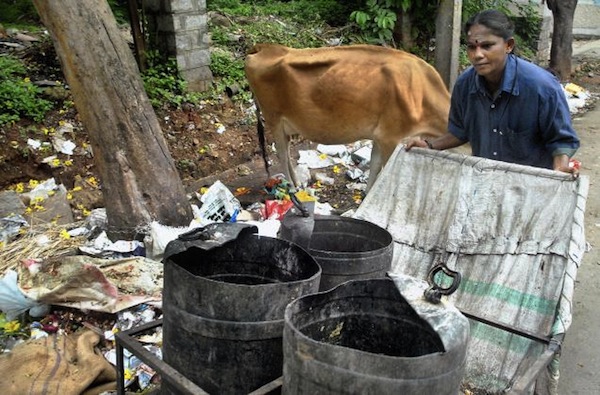

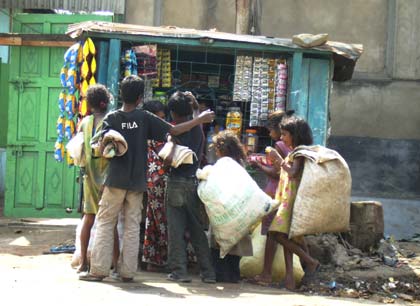
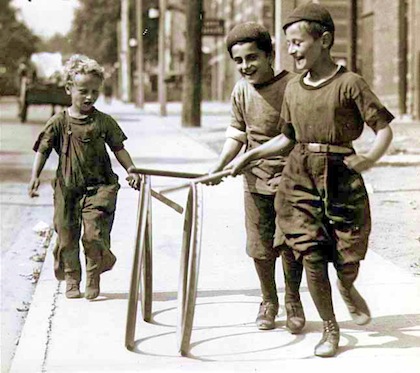
 A pretty obvious one to begin with — the weather here is really different from back in the UK, and particularly from Edinburgh. I’m told that summer “officially” starts here tomorrow with the Maha Shivaratri festival… not sure about that, but it’s certainly warm and sunny now, and in fact it’s been around 30-32°C for 2 or 3 weeks already, and it hasn’t rained in over a month. I’m generally used to the heat now — back home I used to prefer walking around most of the time, but I’ve learned not to do that here when it’s hot, because you quickly get sweaty and exhausted.
A pretty obvious one to begin with — the weather here is really different from back in the UK, and particularly from Edinburgh. I’m told that summer “officially” starts here tomorrow with the Maha Shivaratri festival… not sure about that, but it’s certainly warm and sunny now, and in fact it’s been around 30-32°C for 2 or 3 weeks already, and it hasn’t rained in over a month. I’m generally used to the heat now — back home I used to prefer walking around most of the time, but I’ve learned not to do that here when it’s hot, because you quickly get sweaty and exhausted. Then there are private cars: from the conspicuous wealth in the form of huge 4×4’s, down to the really cool old classic Indian cars: particularly the
Then there are private cars: from the conspicuous wealth in the form of huge 4×4’s, down to the really cool old classic Indian cars: particularly the 
 Next down the list: Tractors! Whether the local Mahindra type, or the familiar Massey Ferguson, tractors are the industrial small vehicle of choice for pretty much everything here. Usually pulling a flat-bed truck, which itself usually has a bunch of daily-waged construction workers — both male and female — sitting in it. The tractors here look pretty much like you’d see on any farm back home, except they have Indian trimmings: eyes painted on, mystic symbols, evidence of puja (chillis/limes on a string), tinsel or flower garlands hanging off the front, etc. They’re usually belching out some pretty dirty fumes.
Next down the list: Tractors! Whether the local Mahindra type, or the familiar Massey Ferguson, tractors are the industrial small vehicle of choice for pretty much everything here. Usually pulling a flat-bed truck, which itself usually has a bunch of daily-waged construction workers — both male and female — sitting in it. The tractors here look pretty much like you’d see on any farm back home, except they have Indian trimmings: eyes painted on, mystic symbols, evidence of puja (chillis/limes on a string), tinsel or flower garlands hanging off the front, etc. They’re usually belching out some pretty dirty fumes.

 And then the “2-wheelers”, as they’re known. By far the most common vehicle, the streets here are absolutely packed with scooters and motorbikes. Again, ranging from the lowliest, decrepit old Bajaj scooter looking like an old Vespa, through lots of more modern scooters and smaller bikes up to the classic, noisy and extremely cool-looking Royal Enfield motorbikes like the
And then the “2-wheelers”, as they’re known. By far the most common vehicle, the streets here are absolutely packed with scooters and motorbikes. Again, ranging from the lowliest, decrepit old Bajaj scooter looking like an old Vespa, through lots of more modern scooters and smaller bikes up to the classic, noisy and extremely cool-looking Royal Enfield motorbikes like the  And further down we go… in the Bangalore traffic eco-system there are quite a few species towards the bottom of the food chain. In order of size and possible priority, you will see Bullock Carts (often carrying pretty heavy loads, like steel girders going to a construction site) and Tangas with their two huge cart-wheels being pulled by a pony.
And further down we go… in the Bangalore traffic eco-system there are quite a few species towards the bottom of the food chain. In order of size and possible priority, you will see Bullock Carts (often carrying pretty heavy loads, like steel girders going to a construction site) and Tangas with their two huge cart-wheels being pulled by a pony. So I guess next lowest in the hierarchy would be tricycles. Most of them here seem to be used by rag-pickers to transport the recyclable garbage they’ve been collecting. (Although I’ve seen one in Jaipur with a 3-piece suite strapped onto the back! Really!) Occasionally you see a tricycle rickshaw here, although they’re not very common. Which is a shame because they’re often beautiful old things, even if they are falling apart.
So I guess next lowest in the hierarchy would be tricycles. Most of them here seem to be used by rag-pickers to transport the recyclable garbage they’ve been collecting. (Although I’ve seen one in Jaipur with a 3-piece suite strapped onto the back! Really!) Occasionally you see a tricycle rickshaw here, although they’re not very common. Which is a shame because they’re often beautiful old things, even if they are falling apart.

